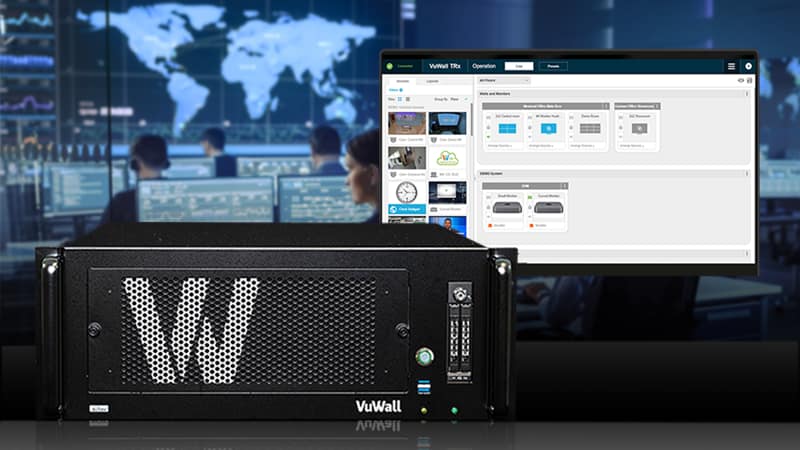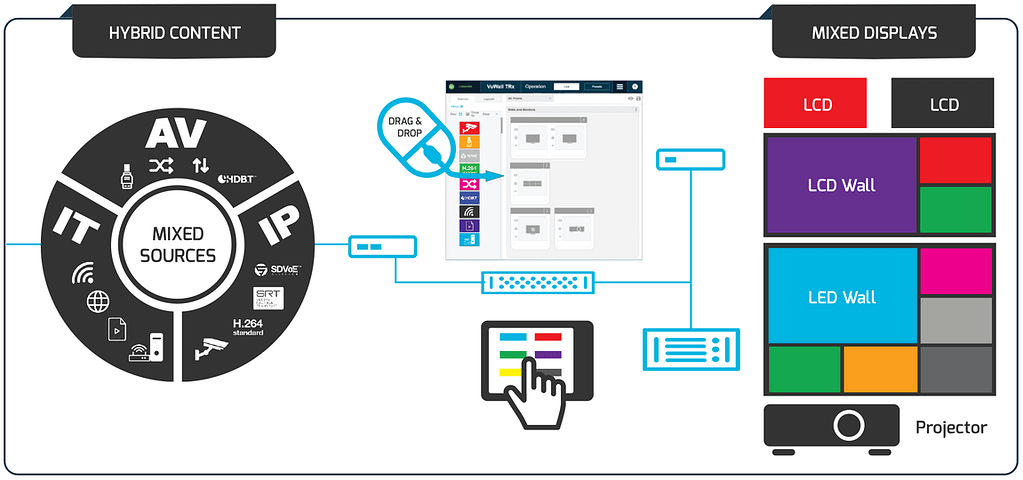
What is a Video Wall Processor?
Many companies and non-profit organizations that are considering implementing a video wall processor may still be unsure on whether it is required or whether it is worth the investment. This is a debate that some companies are still facing as multi-screen displays, known as video walls, are gaining popularity in a wider range of use cases from retail stores to hospitality, sports stadiums, classrooms, control rooms, lobby signage and corporate boardrooms.
While video wall technology may be complex, the reasoning for their widespread use is straightforward: video walls bring an easy solution to a big challenge: how to showcase information to both large and small audiences in a dynamic and adaptable manner. Video walls allow displaying a combination of content coming from multiple sources; they also provide an immersive experience which makes this information more impactful.
In addition to the screens themselves, video walls require advanced technology to make them dynamic and flexible to control what content is presented where, how, and when. This is where video wall processors come into play.
What is a Video Wall Processor or Video Wall Controller?
Briefly defined, a video wall processor (sometimes referred to as a video wall controller) is a piece of software (often installed on a hardware unit) that allows the management of content on multiple monitors in a multi-monitor display or video wall, as a single canvas. A video wall processor gives users the flexibility to visualize any piece of content across multiple screens or the entire video wall. It also allows for multiple pieces of content to be viewed on a single screen, a portion of the video wall or the entire wall, in any one of the unlimited possible combinations. Each display can be controlled individually or in groups, leading to a dynamic display solution that could be utilized to meet a wide range of display requirements while also delivering information effectively and compellingly. The number of monitors in a multi-monitor system might span from two to two hundred or more. The dimension and design of the video wall is determined by the requirements of the target audience.
What is the Purpose of a Video Wall Processor/Video Wall Controller?
Visualization solutions require some type of technology to control what a viewer can see. Consider an air traffic management centre: the more developed and intricate a framework is, the more robust the control system must be. To get the maximum benefit from a multi-monitor setup, maximizing performance, picture quality, security, and automation, a video wall controller is needed.
However, not all video wall controllers are created equally. The best ones offer increased usability, giving an organization’s audio-visual team or video wall operators, the tools they need to get the most out of the technology, right at their fingertips.
Benefits of Video Wall Processors (Video Wall Controllers)
1. There Are No Resolution Restrictions
Resolution is a popular concept. It all comes down to the number of pixels available, we call this “display real estate”: the more pixels on a screen, the higher the pixel density, the more accurate and better the quality of image you will get. It’s easy to see why video wall controllers are very efficient at producing an impressive visual impact based on this flawed concept. When you build a video wall with a series of high-definition screens, the resolution increases incrementally. A video wall can only effectively display high-resolution content without quality degradation if it benefits the support of a powerful digital signal processing unit, i.e. a video wall processor.
2. Signal Processing – Many Sources With Various Formats
The connection and capacity to capture various sources on a single screen or projector is limited. They can interface with a limited number of devices and each screen can only display one specific source at a time. A video wall processor is needed to overcome these limitations so that a video wall can simultaneously display several streams from various sources and source types in any size, configuration or aspect ratio that is desired, across the single logical surface formed by the multiple monitors joined together.
3. Processing Capacity and Performance
Professional high-end controllers bring many other additional benefits like the ability to enable internet access, allowing to display live web sources on the video wall or other apps, like clocks, dashboards, or emergency messaging, all at the same time. In addition to that, they can mix both baseband and IP sources and display them anywhere on the wall. Some even come with control panel designers that would allow you to design buttons on any computer or tablet that would permit users to change layouts on the video wall with a simple click of a button. The right video wall controller can deliver a high level of flexibility and achieve incredible processing performance, resulting in an infinite number of custom configurations for impactful and effective visualization experiences.
VuWall is a world-class manufacturer of professional video wall processors. Their experts are always available to help you with any visualization needs. Book a demo here: vuwall.com/demo For support, visit vuwall.com or contact us anytime at sales@vuwall.com.


